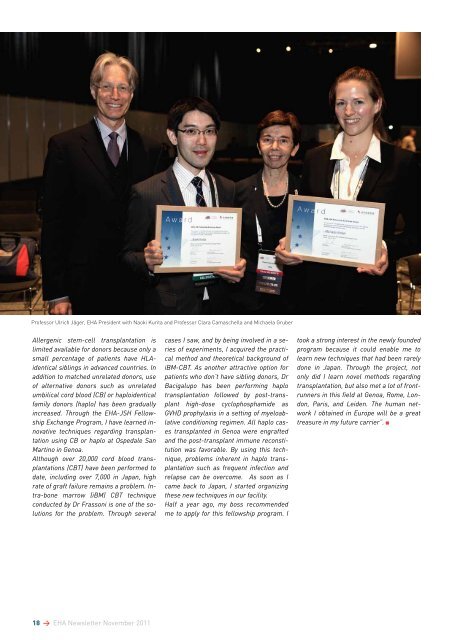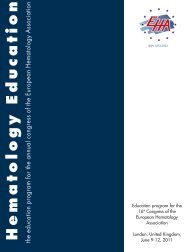Newsletter November 2011 - European Hematology Association
Newsletter November 2011 - European Hematology Association
Newsletter November 2011 - European Hematology Association
You also want an ePaper? Increase the reach of your titles
YUMPU automatically turns print PDFs into web optimized ePapers that Google loves.
Professor Ulrich Jäger, EHA President with Naoki Kurita and Professor Clara Camaschella and Michaela Gruber<br />
Allergenic stem-cell transplantation is<br />
limited available for donors because only a<br />
small percentage of patients have HLAidentical<br />
siblings in advanced countries. In<br />
addition to matched unrelated donors, use<br />
of alternative donors such as unrelated<br />
umbilical cord blood (CB) or haploidentical<br />
family donors (haplo) has been gradually<br />
increased. Through the EHA-JSH Fellowship<br />
Exchange Program, I have learned innovative<br />
techniques regarding transplantation<br />
using CB or haplo at Ospedale San<br />
Martino in Genoa.<br />
Although over 20,000 cord blood transplantations<br />
(CBT) have been performed to<br />
date, including over 7,000 in Japan, high<br />
rate of graft failure remains a problem. Intra-bone<br />
marrow (iBM) CBT technique<br />
conducted by Dr Frassoni is one of the solutions<br />
for the problem. Through several<br />
18 > EHA <strong>Newsletter</strong> <strong>November</strong> <strong>2011</strong><br />
cases I saw, and by being involved in a series<br />
of experiments, I acquired the practical<br />
method and theoretical background of<br />
iBM-CBT. As another attractive option for<br />
patients who don’t have sibling donors, Dr<br />
Bacigalupo has been performing haplo<br />
transplantation followed by post-transplant<br />
high-dose cyclophosphamide as<br />
GVHD prophylaxis in a setting of myeloablative<br />
conditioning regimen. All haplo cases<br />
transplanted in Genoa were engrafted<br />
and the post-transplant immune reconstitution<br />
was favorable. By using this technique,<br />
problems inherent in haplo transplantation<br />
such as frequent infection and<br />
relapse can be overcome. As soon as I<br />
came back to Japan, I started organizing<br />
these new techniques in our facility.<br />
Half a year ago, my boss recommended<br />
me to apply for this fellowship program. I<br />
took a strong interest in the newly founded<br />
program because it could enable me to<br />
learn new techniques that had been rarely<br />
done in Japan. Through the project, not<br />
only did I learn novel methods regarding<br />
transplantation, but also met a lot of frontrunners<br />
in this field at Genoa, Rome, London,<br />
Paris, and Leiden. The human network<br />
I obtained in Europe will be a great<br />
treasure in my future carrier”.












